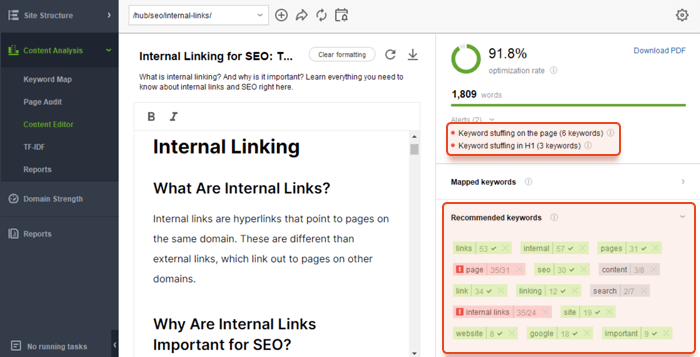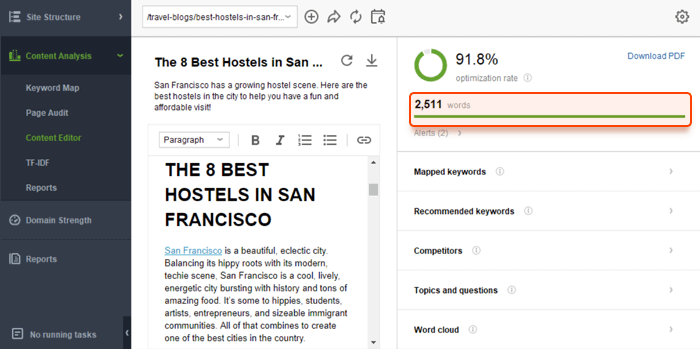19321
•
8-minute read


One of the most frequently asked questions in the SEO community is about updating old content. Provided the topic is the same, should you refresh an old page or publish a new one?
It seems like the current consensus is in favor of updating an old page. The prevailing argument is that old pages already have some traction with Google. They’ve been ranked and re-ranked, there might be some backlinks attached, along with a history of user behavior and other favorable ranking signals. So, an old page gives you a headstart when publishing and ranking content, whereas with a new page you would have to build your ranking from scratch — it’s more of a gamble.
There is also some anecdotal evidence to back this approach up. SEOs generally report good results doing maintenance for old pages. With annual updates, a solid pillar page will easily hold or even grow its rankings over a long time, some still going strong after ten or more years.
Anecdotal evidence aside, what are some tangible benefits of updating old content?
The most immediate effect of updating a piece of content will be on the click-through rate in SERP. People are naturally biased towards newer information. When presented with several options in search results, they would often go with the most current one:

In the example above, I’m using a tech-related query, and tech products evolve quickly, so I would probably want the latest information. Of the three results in the screenshot, I’m likely to pick the one from 2020 over the ones from 2018 or 2019.
Sometimes I’m so desperate for the latest information that I would make it a part of my query, like best portrait lens 2020. And if I’m really really desperate, then I will go as far as using search tools and asking Google for a desired level of freshness:

Obviously, freshness is not the only factor influencing the click-through rate. But it’s hard to come up with a case where offering the latest information would be a disadvantage in SERP. So, it might not always be useful, but it’s definitely not gonna hurt your chances.
Updating an old piece of content will have a positive effect on a couple of known ranking factors, which may improve your positions in search:

Above is the average position of one of our older blog posts. Originally, the post was published in 2018 and its search performance has been on a steady decline for the past two years. But then an update came in 2020, followed by an immediate recovery to slightly above the initial position.
The recovery had likely happened due to several ranking factors being triggered at once. The most obvious one is content freshness, although it is rarely a big ranking factor for anything outside of news and trendy topics. I expect that the recovery was rather due to improved content quality and an influx of user behavior signals (clicks, shares, and comments).
Updating and republishing an old piece of content is a huge time saver. It’s already researched, the structure is in place, and most of the copy is likely to stay unchanged, so the effort required is mostly superficial. As a rule of thumb, you can update about four old pages in the time it would take you to create one from scratch.
And the best thing is that there are no downsides. We’ve found that properly updated blog posts are as popular with our readers as new posts. So, for a quarter of your resources, you get a piece of content that performs at least as well, possibly even better.
Creating a new piece of content is usually an intensive process. There is the pressure of a deadline and the prime concern is to create a minimally viable product that’s just good enough. But when you update a piece of content, you finally get to focus on all the little extras that could take it to a whole other level.
Have you ever encountered those mammoth pillar pages published by your competitors and marveled at the effort it must have taken to create them? Well, it is more than likely that those pages have been through multiple iterations and took many years to make. That’s the power of updating content. Instead of being stuck publishing basic content over and over, you get to grow existing pieces into something much more valuable.
As there are probably hundreds of pieces of content on your website, you have to choose which ones are worth updating. There is definitely a method to the selection process and some pages will yield much better results than others. Here are the things to look for:
If you plan to distribute an updated piece of content to your subscribers, then it has to be something that’s still of interest today. Think of your pillar pages first — those big guides that are good to go at any time. Then seasonal posts, most likely listicles, that can be updated annually. And finally, look for posts that correspond to the recent events in your field. For example, we have an article about recovering from a sudden drop in rankings and it is always a big hit around major Google updates.
There is little point in updating pages that already rank among the top three or five search results — it’s not going to translate into any more clicks. There is equally little point in updating pages that are ranking at the bottom of page two or worse — they are unlikely to make the jump to meaningful positions.
The ideal candidates are the pages that are on the verge of gaining visibility and all they need is a little push. To find these pages, go to Google Search Console > Search Results, filter your ranking keywords to show those ranking in positions 15 and up. Now scroll through the list and look for evergreen topics that might benefit from an update:

Again, if your plan is to send an updated piece to your subscribers, then it has to seem new. Which means it can’t be something they’d easily remember reading on your website. As a rule of thumb, don’t republish anything less than a year old, although you can decide on what makes sense for your particular audience.
One way you can do that is by looking at the lifetime of your subscribers. For example, the majority of our email subscribers remain active readers for about half a year, and then the open rate drops off quite quickly. So, theoretically, it’d be safe for us to republish content that’s just half a year old.
URLs that give away the age of the content may cause suspicion among your readers and are generally considered to be a bad user experience. When your title says Top 12 Gravel Bikes to Buy in 2020, but your URL is one of these:
/8-best-gravel-bikes
/2017/05/best-gravel-bikes
/top-12-gravel-bikes-to-buy-in-2018
Well, some users may find your content untrustworthy. If you’ve made the mistake of freezing your URLs in time, then you’d have no choice but to redirect the pages to their newer versions.
When updating an old page, the goal is to deliver a good user experience to your readers and to convince Google that the page has made meaningful improvements. Following is a checklist of things that will help you achieve both:
The current best practice is to keep the original date and add the “last updated” date to your content. Sometimes it is even a good idea to add the word “updated” to the title and/or place a disclaimer at the top of the page. The best approach is to be upfront about the fact that the content is updated, so that you don’t create any false expectations for your readers.
Images tend to deteriorate much quicker than copy and will immediately betray an updated piece of content. Make sure your images don’t display outdated interfaces, changed skylines, older product models, and dated cultural references.
Click on every single link in your copy and check whether it leads to the intended destination. In case linked content is missing or is hopelessly outdated, look for a more recent alternative.
You can actually avoid some manual labor and find broken links at scale. In the WebSite Auditor, go to Site Structure > Site Audit and check out the Broken links section. There you will find a full list of all the broken links from your entire website — no need to go page by page and then link by link.

The bare minimum is to remove outdated talking points and to add recent developments. If you want to go a step further, you can check competitors’ content and see if they’ve come up with anything new, check the comment section for criticism and improvement suggestions from your past readers.
Google’s preference for keywords is always changing. A combination of keywords that worked fine a year ago is probably not your best choice today. So another thing you’d want to do when updating content is get your keyword saturation to the current standard.
Launch WebSite Auditor, open or create a project for your website, and go to Content Analysis > Content Editor. There, you can add the page you want to optimize and get keyword recommendations based on your top-ranking competitors:

Conveniently, you can edit the page right in the tool, until you are satisfied with its optimization score. When you are done, download the page and upload it to your website.
Although word count is not necessarily a ranking factor, it is a good indicator of the expected depth of your content. One way we use word count in the WebSite Auditor is we analyze the content of your top competitors' pages and calculate the average length of their pages:

So, when you are updating an old page, you can benchmark your word count against those who are currently successful in SERP. The number is not meant as a strict requirement, more of a recommendation. If your own word count is significantly under or over, then perhaps you have missed some of the new talking points or forgot to remove some of the old ones.
What do you do with old comments when updating content? Some say you should keep them as they demonstrate user engagement. Others say delete them because they betray the true age of your content and put your readers off leaving new comments.
From an SEO perspective, it has been somewhat proven that comments do not have a strong effect on your rankings, so you are not running any risks when removing old comments. At the same time, there is no evidence of old comments having adverse effects on user experience, so you are free to keep them if you like.
The final step in updating old content is delivering it to your audiences. If you have an active subscriber base or a social media following, then you can distribute an updated piece, get some traffic to your page, display some of those controversial user behavior signals, and possibly contribute to your rankings.
There are two basic approaches to incorporating updated posts into your content plan:
The retroactive approach is for those who have accumulated years of old posts and want to start reusing them going forward. What you have to do is audit your content to find the posts with good update potential. Make a list, and splice these posts into your content plan.
This is what we are currently doing at SEO PowerSuite. We’ve identified several dozen high-potential blog posts from the past three years and have been gradually incorporating them into our publishing schedule. Right now we publish one updated post per five new ones.
As soon as you publish an evergreen post, mark it down for a future update. Whether it will be a year from now or two years from now, add it to your content plan and set up a reminder in your calendar. This way you will also have a place to save random update ideas, so when the time comes you will have plenty of improvements to work with.
We have also started on this approach recently and have already scheduled some posts as far as two years out. I imagine this approach would be a huge time saver once these scheduled posts start rolling in.
Updating old content is an often overlooked SEO strategy. Unjustly so. It doesn’t seem to have a single downside — it saves time exponentially, delivers a near-guaranteed boost in rankings, and provides a superior user experience. Unless I’m missing something. What has been your experience with updated content?